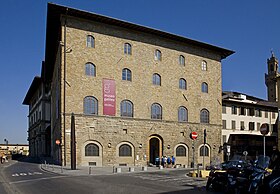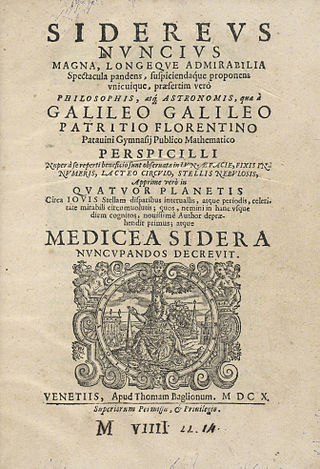
Sidereus Nuncius is a short astronomical treatise published in Neo-Latin by Galileo Galilei on March 13, 1610. It was the first published scientific work based on observations made through a telescope, and it contains the results of Galileo's early observations of the imperfect and mountainous Moon, of hundreds of stars not visible to the naked eye in the Milky Way and in certain constellations, and of the Medicean Stars that appeared to be circling Jupiter.

Cosimo II de' Medici was Grand Duke of Tuscany from 1609 until his death. He was the elder son of Ferdinando I de' Medici, Grand Duke of Tuscany, and Christina of Lorraine.

Eustachio Divini was an Italian manufacturer and experimenter of optical instruments for scientific use in Rome.

Galileo di Vincenzo Bonaiuti de' Galilei, commonly referred to as Galileo Galilei or mononymously as Galileo, was an Italian (Florentine) astronomer, physicist and engineer, sometimes described as a polymath. He was born in the city of Pisa, then part of the Duchy of Florence and present-day Italy. Galileo has been called the father of observational astronomy, modern-era classical physics, the scientific method, and modern science.
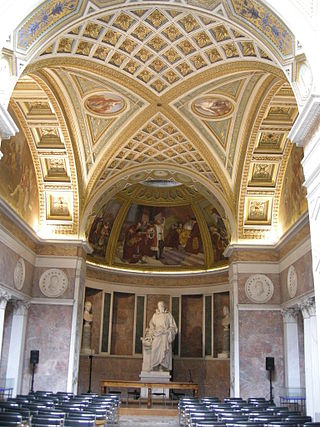
The Tribune of Galileo is a Neoclassic architectural addition, built to commemorate the famous Florentine scientist, Galileo Galilei and to house some of his scientific instruments.
Paolo Galluzzi is an Italian historian of science.
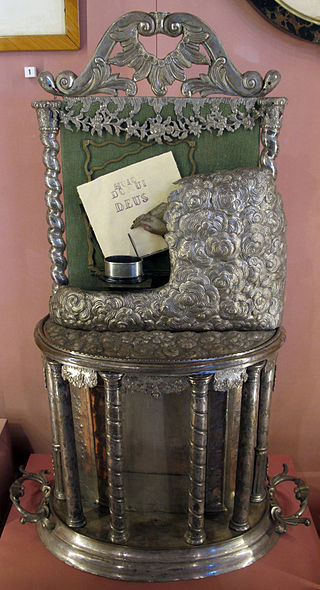
The writing hand is a mechanical automaton created by Friedrich von Knauss in 1764. A clockwork mechanism moves a hand which dips a pen into an inkstand and writes the phrase "Huic Domui Deus / Nec metas rerum / Nec tempora ponat" on a small card. On the silver-coating of the mechanism are the words "Pro patria".
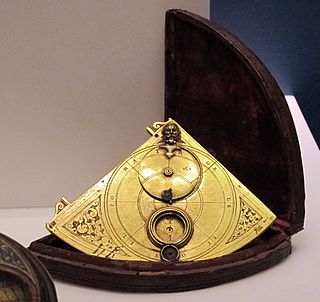
Giovanni Battista Giusti was a scientific- instrument maker. Giusti worked as a scientific-instrument maker in Florence for the Grand Duke's workshops around the mid-sixteenth century.
Antonio Santucci (?–1613) was an Italian astronomer, cosmographer, and scientific instrument maker.

The jovilabe is a brass scientific instrument, undated and of unknown maker, currently in the collection of the Museo Galileo in Florence, Italy.

Galileo's objective lens is a specific objective lens held in the Museo Galileo, Florence, Italy. It was used by Galileo Galilei in the Galilean telescope with which he discovered the four largest moons of Jupiter in 1610. The lens has a diameter of 38mm and a gilt brass housing. The frame is made of ebony and ivory and has dimensions of 410mm x 300mm.
The Campani compound microscope is a microscope on exhibit at the Museo Galileo in Italy, thought to have been built by optical instrument maker Giuseppe Campani in the second half 17th century. For a time it was thought to have been built by Italian scientist Galileo Galilei but no longer bares that attribution.
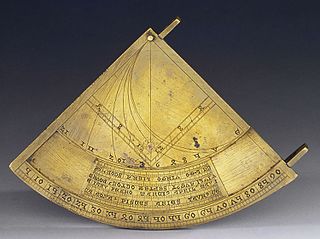
The Quadrans Vetus is a medieval astronomical instrument.

The Tabula Affinitatum is a table of chemical affinities between substances.

The elastic and inelastic collisions apparatus is a large apparatus to study elastic and inelastic collisions.

The mechanical paradox is an apparatus for studying physical paradoxes. It consists of a trapezoidal veneered wooden frame with two brass rails, and a pair of brass cones joined at their bases by a wooden disk which rests on the rails. When the double cone is placed at the low end of the frame, it automatically starts to roll upward, giving the impression of escaping the universal law of the gravitational force.

The Reale Museo di Fisica e Storia Naturale was an Italian museum founded on 22 February 1775 in Florence that survived until 1878, when its collections were split up in various Florentine museums.
Nuncius: Journal of the Material and Visual History of Science is a triannual peer-reviewed academic journal covering the history of science, especially the "historical role of material and visual culture in science". The journal was established in 1976 by Maria Luisa Righini Bonelli as the Annali dell'Istituto e Museo di storia della scienza di Firenze. The journal changed its publisher in 2011. It is published by Brill Publishers and the editor-in-chief is Elena Canadelli of the University of Padua, Italy.
Maria Timpanaro Cardini was an Italian philologist who studied the history of ancient philosophy and history of science.
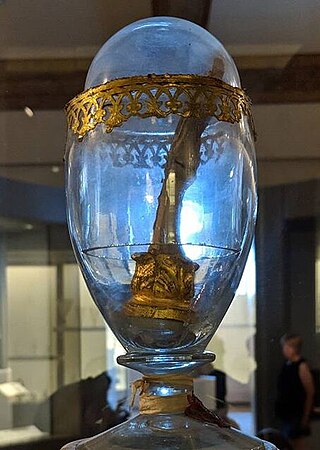
The middle finger from the right hand of Italian astronomer Galileo Galilei (1564–1642) is a secular relic in the collection of the Museo Galileo in Florence, Italy. The finger was removed from his body after his death, and is encased in a gilded glass egg.
